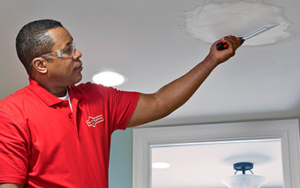Landscaping Springdale AR is the design, installation, and maintenance of outdoor spaces. It involves planting trees, shrubs, and flowers, modifying the terrain, and building structures like patios, walkways, fences, and walls.

A well-designed landscape can add value to your property and improve the quality of your life. It can also reduce your water usage, minimize pesticide and fertilizer needs, and support local wildlife.
Professionals often use the principles of hierarchy, transition, and unity to enhance their designs. Hierarchy refers to the visual cues used to draw attention and establish order. These include scale, proportion, color, and placement of the elements. These are important when creating a garden layout because they help create the visual illusion of space and size.
Transition is the gradual change from one part of the design to another. This is accomplished by using various techniques, such as varying plant heights, colors, and textures. These techniques also create movement, a sense of direction, and visual interest. Lastly, transition is achieved by connecting different areas of the garden with visual cues, such as a wet or dry creek bed that flows through the landscape.
The final aspect of the landscaping design is the integration of hardscapes, or features such as patios and walkways. Skilled designers can use a variety of hardscaping materials, from natural stone pavers to sleek concrete surfaces. In addition, they can integrate a variety of water features, including cascading waterfalls and tranquil koi ponds.
A landscape that blends softscaping and hardscaping is a great way to increase the value of your property. A beautifully cultivated backyard can also improve your health, and studies have shown that being outdoors helps reduce stress. In addition, spending time in nature increases the production of endorphins, the body’s natural feel-good chemicals.
If you are interested in improving your outdoor spaces, start by making a list of your priorities and needs. Identify the elements you want to include in your landscape, such as a vegetable garden or large tree canopy. Then, make a detailed plan to guide your landscape installation. Finally, choose the right plants for your area and prepare the soil by testing its pH level and amending it with organic matter.
It involves the maintenance of outdoor spaces
Many people think of landscaping as planting trees and shrubs and mowing lawns, but this is only part of the story. The art and science of landscape design is much more complex, involving sod work, installing retaining walls, interlocking driveways, and more. These services can increase your property value and add functionality to your outdoor space.
Landscaping professionals have horticultural skills and can work with you to come up with reliable ideas associated with softscapes, such as flower beds and lawns. They also have construction knowledge and can build retaining walls, lay pavers for walkways, and more. They can create a beautiful and functional outdoor space that will be enjoyed by everyone who visits your home or business.
The different elements of a landscape must be in proportion to each other to create a cohesive whole. This is especially important when creating a walkway, as it should blend seamlessly into the surrounding environment. There are a variety of ways to achieve this balance, including the use of rhythm and repetition, as well as color and texture.
In addition to aesthetics, a well-maintained landscape can have positive effects on your health and wellbeing. Studies have shown that being surrounded by plants can reduce stress, improve air quality, and encourage physical activity. In addition, the right plants can help control erosion, and improve the water quality of your garden.
Landscape maintenance includes seasonal tasks that are typically performed on a weekly, biweekly, or monthly basis. The frequency of maintenance depends on the local climate, soil type, and desired appearance of the outdoor space. In addition, some maintenance tasks may be necessary due to damage caused by storms or pest infestations.
The landscape industry is a diverse field, and it includes a wide range of career specialists. These include agronomists who work below ground, and arborists who work above ground. These professionals play a vital role in the health of our green spaces, and there are many career paths for those who want to make a difference. Whether you’re a soon-to-be graduate, a sales professional, or a scientist, you can find a place for yourself in this exciting and rewarding career.
It involves the installation of plants
Depending on the project, landscaping can involve planting trees and shrubs or installing hardscaping elements such as walkways and retaining walls. Professional landscapers also perform maintenance tasks such as weeding, watering, pruning, and insect management. They must be familiar with the local climate and soil conditions to ensure that the plants will thrive.
Plants can add color, texture and visual weight to the landscape. They can be used to create a theme or highlight specific areas of the property. Themes can be geometric, such as a circle or square, or more naturalistic, such as curvilinear or meandering lines. Themes can also be based on colors, with a single color being repeated throughout the design or contrasting shades being used to create a contrast.
Another important aspect of the landscape is its transition between different areas. The elements should blend seamlessly to create a unified whole, with the transitions between the hardscape and the softscape working together. For example, a paving material should not abruptly end at the edge of a lawn. A landscape should also have a theme of rhythm, with repetition of certain features, such as tree groups, to create continuity.
Landscaping is beneficial to the environment and can increase a home’s value. It is also believed to improve mental health by reducing stress levels and improving focus and memory. Additionally, studies show that people who live in neighborhoods with community green spaces have lower blood pressure than those who don’t.
A professional landscaper can help you choose the best plants for your home and install them properly. They will also be able to access unique plants that you may not be able to find at a local nursery or big box store. In addition, they can provide advice on how to care for your plants and can make recommendations based on the type of soil and climate in your area. This can save you time and money, and it will keep your landscape looking its best for years to come.
It involves the installation of other elements
A well-designed landscape can increase the value of a home, and it is often the first thing prospective buyers notice. A landscaped property can also help to reduce pollution and protect against erosion. A professional can help you design a unique and beautiful garden that suits your needs and preferences. In addition to plants, landscape professionals can install other elements like walkways and patios.
The principles of landscape design use horticultural science and artful composition to create attractive outdoor spaces for different uses. They apply a series of concepts, including line, form, color, and visual weight to balance and connect the different components of a landscape. They also use principles such as dominance, interconnection, and repetition to create rhythm and unity in the landscape.
One of the most important principles is line. Lines can be created vertically, horizontally, or curvilinearly and are essential for creating structure in a garden. Creating lines in your landscape can be as simple as lining up three identical plant or pots in a row or as complex as designing a path using stone, wood, or brick. These lines can be curved or straight and should complement the overall theme of your landscape.
Contrast is another key principle of landscape design. Adding contrast to your landscape can add visual interest and draw the eye of the viewer. It can be achieved by using different colors, plant sizes, textures, and leaf structures. A variety of textures can also create visual interest, especially when the smooth and rough surfaces are combined.
Another important aspect of landscape design is the creation of transitions. These transitions should be smooth and gradual. For example, a pathway should not end abruptly in the middle of the garden. It is also important to create a sense of unity and harmony in the landscape.
Landscapes are constantly changing and eroding due to natural weather conditions, soil conditions, and root systems. To help your garden survive, you should plan and install drainage systems to prevent water runoff and soil erosion. This will ensure that your garden is healthy and vibrant. In addition, it can reduce your utility bills by preventing the overuse of water.

